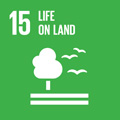- Docente: Francesco Maria Sabatini
- Credits: 6
- SSD: BIO/03
- Language: Italian
- Moduli: Francesco Maria Sabatini (Modulo 1) Riccardo Testolin (Modulo 2)
- Teaching Mode: In-person learning (entirely or partially) (Modulo 1); In-person learning (entirely or partially) (Modulo 2)
- Campus: Bologna
-
Corso:
Second cycle degree programme (LM) in
Sciences and Management of Nature
(cod. 9257)
Also valid for Second cycle degree programme (LM) in Planning and management of agro-territorial, forest and landscape (cod. 8532)
Learning outcomes
At the end of the course, the student has acquired knowledge of the main Italian vegetation ecosystems, as well as the habitats protected at European level (Habitat Directive 92/43/EEC) related to them and the main regional, Italian and European regulations and instruments for the conservation of biodiversity. In particular, the student is able to - characterise ecosystems and habitats as a function of their dynamic stability/instability in anticipation of the interventions to be undertaken for their conservation management; - assess the role that the ecosystems and habitats treated play in the conservation of biodiversity in the Italian and European territory; - choose the species suitable for environmental restoration and design the ways in which they can be inserted into the environment. Finally, the student has direct knowledge of the main woody and/or herbaceous species that characterise the ecosystems and habitats treated.
Course contents
MODULE 1 - Elements of plant ecology, vegetation and landscape science (Dr. Francesco Maria Sabatini)
Elements of Plant Ecology (6 hours)
Ecological factors influencing the life and distribution of plants and habitats (Light, Temperature, Water, Nutrients). Dispersion. Biotic interactions. Ecological niche.
The ecosystem: general concepts, components, delimitation, balance, vulnerability and resilience. Stress and disturbance. Carbon cycle, primary productivity and ecosystem services.
Evolution of vegetation over time (outlines of earth history, glaciations, human-induced changes)
Knowledge acquired
Acquisition of basic knowledge of ecology to frame the territory in the ecosystem concept.
Vegetation and its spatial organisation (9+10 hours)
Flora and vegetation. Climate and vegetation relations. Spatial distribution of plant communities. Kingdoms, Biomes, Ecoregions. Vegetation dynamics. Vegetation and habitats.
Growth forms. Vegetation classifications (physiognomic, syntaxonomic and European). Methods of studying and sampling vegetation and plant communities. Cartographic representations. Species ranges and Chorotypes. Niche-Area correspondence.
Altitudinal belts, with particular reference to Italy and Europe. Climatic, pedological and forest vegetation characteristics of the Mediterranean, basal/supramediterranean, mountain, subalpine belts.
Distribution, ecology and role of the main Italian forest species belonging to the above-mentioned vegetation belts. In particular:
- Mediterranean belt (Quercus ilex, Quercus suber, Quercus coccifera, Quercus calliprinos, Ceratonia siliqua, Olea europaea var. sylvestris, Pinus pinea, Pinus pinaster, Pinus halepensis and other minor species).
- Basal/supramediterranean belt (Quercus robur, Quercus petraea, Quercus pubescens, Quercus frainetto, Quercus cerris, Quercus trojana, Quercus macrolepis, Carpinus betulus, Carpinus orientalis, Ostrya carpinifolia, Laburnum anagyroides, Acer campestre, Acer opulifolium, Acer obtusatum, Acer neapolitanum, Fraxinus ornus, Castanea sativa, Salix sp. pl., Alnus incana, Alnus glutinosa, Alnus cordata, Fraxinus oxycarpa, Ulmus minor).
- Mountain belt (Fagus sylvatica, Abies alba, Acer pseudoplatanus, Acer platanoides, Fraxinus excelsior, Ulmus glabra, Tilia cordata, Tilia platyphyllos, Prunus avium, Taxus baccata, Ilex aquifolium, Pinus sylvestris, Pinus nigra, Pinus laricio, Pinus leucodermis).
- Subalpine belt (Picea abies, Larix decidua, Pinus cembra, Pinus uncinata).
- Notes on the woody pioneer species involved in the dynamic series of the different vegetation belts.
Excursion: Parco dei Gessi Bolognesi
Exercise: Determination of plant species (2 parts)
Excursion: Parco Nazionale delle Foreste Casentinesi
Knowledge acquired
Learning of methodologies and tools useful for the study and analysis of vegetation for its evaluation, monitoring and management. Acquisition of the theoretical assumptions of vegetation science. Knowledge of the main Italian forest ecosystems, the most common woody species present in them, their ecology, their dynamic role and their reference value as autochthonous climax communities.
Elements of landscape ecology (3+2 hours)
Structure, function and change of the plant landscape. The patch mosaic model (patches, corridors, matrices). Ecological networks. Heterogeneity. Landscape and disturbance.
Exercise: Calculating key landscape metrics with QGIS
Knowledge acquired
Knowledge of the principles of landscape ecology.
Project with final paper
Ecosystem framing of two case studies: Foreste Casentinesi National Park, and a case of choice in highly anthropised environments (e.g. Po Valley). Presentation of the project. Identification of the forest communities present and of the climax phase, and of the factors influencing/obstructing/modifying its attainment, or threatening its maintenance. Dominant species. Ecosystem services.
MODULE 2 - Biodiversity, conservation and environmental restoration (Dr. Riccardo Testolin)
Conservation of ecosystems and vegetation (6+8 hours)
Theoretical outlines on the conservation of ecosystems. International (CITES, Ramsar, CBD, etc.) and European (Birds and Habitats Directives) conventions on nature conservation.
Parks, ecological restoration areas, Natura 2000 network (SCIs, SPAs and SACs).
Examples of natural and semi-natural habitats protected at European level that are particularly widespread in Italy and the region. CORINE and EUNIS systems for the census of European habitats.
Excursion: Parco dei Gessi Bolognesi.
Exercise: Photo-interpretation of Foreste Casentinesi National Park habitats with classification according to CORINE, EUNIS, Habitat Directive.
Excursion: Parco Nazionale delle Foreste Casentinesi.
Acquired knowledge
Knowledge of nature protection systems in Italy and Europe. Knowledge of codified systems for the description of territorial biodiversity.
Biodiversity and its threats (6+2 hours)
Biodiversity and its patterns at different spatial scales and levels of organisation.
Measures of biodiversity: indices and estimators.
Threats to biodiversity (land use changes, climate change, pollution of environmental matrices, invasive species) and their effects (ecosystem degradation, habitat fragmentation and loss, loss of ecosystem services).
Exercise: Numerical analysis of biodiversity.
Knowledge acquired
Knowledge of biodiversity concepts and indices for its quantitative and qualitative assessment. Knowledge of the main threats to biodiversity conservation.
The restoration of biodiversity (8 hours)
Principles of restoration ecology. Site assessment. Selection and sourcing of species.
Analysis of environmental restoration projects. Monitoring of implemented interventions and analysis of results.
Knowledge acquired
Acquisition of the principles of restoration ecology. Ability to correctly set up an environmental restoration intervention.
Exercise: Discussion of environmental restoration projects.
Final Project
Analysis of an environmental restoration project, from planning to the final result, highlighting effectiveness and possible criticalities.
Readings/Bibliography
The lecturer will provide pdfs of texts, monographs and scientific articles on each of the topics covered in the lecture, as well as pdfs of each lecture once the topic has been completed.
Reference texts for the course include:
Blasi, C., Boitani, L., La Posta, S., Manes, F., & Marchetti, M. Stato della biodiversità in Italia. Ministero dell'Ambiente e della Tutela del Territorio. Direzione per la Protezione della Natura, 2005
Blasi, C. La Vegetazione d'Italia. Palombi & Partner S.r.l., Roma, Italy, 2010
Ferrari C., Pezzi G. L’Ecologia del Paesaggio. Il Mulino Universale, 2013
Giacomini, Valerio. La flora. Conosci L'Italia Vol. 2. Touring Club Italiano, 1958
Magurran, A E.; McGill, B J (ed.). Biological diversity: frontiers in measurement and assessment. OUP Oxford, 2010.
Schulze E-D, Beck E, Buchmann N, Clemens S, Müller-Hohenstein K, Scherer-Lorenzen M. Plant Ecology.Springer Berlin, Heidelberg, 2019
Van Andel, Jelte, and James Aronson, eds. Restoration ecology: the new frontier. John Wiley & Sons, 2012.
Not all the content of the recommended texts is actually to be considered for the preparation of the examination, and the purchase of the volumes is not recommended. The student should therefore select from the topics covered in the texts, those that are to be studied for the preparation of the examination, referring to what is detailed in the syllabus.
Most of the texts are available for consultation at the University libraries.
Teaching methods
The course is mainly carried out through (i) lectures with video projection and (ii) practical exercises under the guidance of the lecturer relating to (a) planning and execution of vegetation surveys and identification of plant species, and (b) analysis of data collected in the field or derived from remote sensing in a suitably equipped computer room, as detailed in the programme. These teaching methods may be supplemented with the organisation of seminar meetings with technical experts on specific topics of the teaching programme.
As concerns the teaching methods of this course unit, all students must attend Module 1, 2 [https://www.unibo.it/en/services-and-opportunities/health-and-assistance/health-and-safety/online-course-on-health-and-safety-in-study-and-internship-areas] online, while Module 3 on health and safety is to be attended in class. Information about Module 3 attendance schedule is available on the website of your degree programme.
Assessment methods
The teaching is part of Integrated Course 27362 (Ecosystem Monitoring) together with teaching 27364 - Forest Inventories and Remote Sensing.
Therefore, the assessment of the integrated course jointly takes into account the level of knowledge and skills acquired by the student in relation to the contents of both subjects. The knowledge and skills imparted by this teaching are assessed as detailed below.
The assessment test is oral and includes the discussion of applications and individual projects developed in the course of the exercises and related theory. Attendance to the lectures is not compulsory and non-attending students may develop their own papers using the detailed handouts provided by the lecturer.
Assessment is based on the individual student's knowledge of the topics in the syllabus and the content of the exercises and the quality of the presentation. The duration of the oral examination averages 45 minutes.
Teaching tools
PC, video projector. Computer room with individual workstations equipped for data processing with freeware software (R) and geographical data analysis with freeware software (QGIS). Tools for vegetation survey and plant species identification.
All teaching material is made available to students in advance via the Virtual Portal (virtuale.unibo.it).
Office hours
See the website of Francesco Maria Sabatini
See the website of Riccardo Testolin
SDGs


This teaching activity contributes to the achievement of the Sustainable Development Goals of the UN 2030 Agenda.
